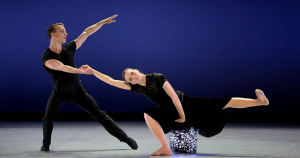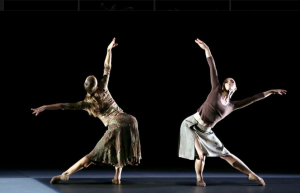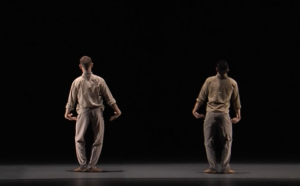Malandain Ballet Gets Lemons, Makes Lemon Mousse
Romeo and Juliet missed a critical connection, and so did the costumes and sets for the “Roméo et Juliette” that Malandain Ballet Biarritz was going to perform here on Sunday. Luckily, the French dance troupe fared better than the star-crossed lovers. When they realized the ship with their costumes and sets was still somewhere in the Atlantic, they ran out to a mall in Dallas, their first U.S. stop, and bought what they needed to stage three less elaborate pieces. Judging by the standing ovation at the Civic Theatre on Sunday, they didn’t disappoint.
Malandain Ballet Biarritz is one of 19 French regional dance companies, and wow! what generous government funding for the arts can accomplish. The sheer level of performance from the 22-member company is thrilling. Artistic director/choreographer Thierry Malandain gives these classically trained dancers the contemporary style—fluid spines, swivelly hips, no toe shoes—common in European ballet, and they are masters of it.
The three works shown on Sunday had a common vocabulary: classical lines deformed by a jutting hip or deeply flexed foot, more or less geometric formations, canons (one dancer starts a move, the next follows a beat or two later, and so on). And there’s a lot of playfulness—dancers shoving each other like bratty kids, or lying prone like a line of logs across the stage while others hop over them.
What’s freshest and most exciting about Malandain’s work is his push-pull relationship to music. Sometimes he lets the music dictate the mood in a dance; and sometimes, he works against it, creating a delicious tension. This happens brilliantly in “Nocturnes,” a 2014 piece to Chopin nocturnes. Two men rise from the floor doing soulful reaches, like artists tormented by melancholy … but suddenly, their backs to us and wrists awkwardly flexed, they go into a goofy penguin waddle. In another section, Malandain takes aim at “Swan Lake:” two horizontal lines of four women each, arms linked, suggest the four little swans. And they do the famous arabesque penchée (one leg extended behind, the torso leaning forward), but it turns gawky and anti-romantic as each woman grabs the ankle of the one in front of her.
For all the jokiness, “Nocturnes” is lovely, the irony superbly balanced by the beauty; Malandain resisting the romanticism of the music yet at the same time letting it sing through the dancers’ bodies.
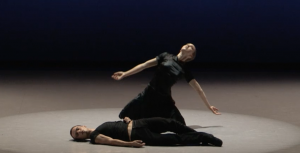 The tension in “Estro” (2014), which opened the program, is between the two Vivaldi works, Stabat Mater and L’Estro Armonico Op. 3, to which it’s set. “Estro” bounces back and forth between them—going from Mary, lamenting with wide, yearning arms over an inert Jesus (reflecting the words of this vocal piece), to sprightly courting and clowning, and back to Mary again.
The tension in “Estro” (2014), which opened the program, is between the two Vivaldi works, Stabat Mater and L’Estro Armonico Op. 3, to which it’s set. “Estro” bounces back and forth between them—going from Mary, lamenting with wide, yearning arms over an inert Jesus (reflecting the words of this vocal piece), to sprightly courting and clowning, and back to Mary again.
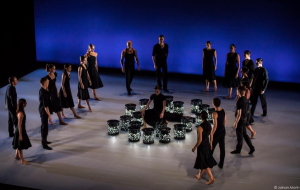 It’s a jerky ride, which may be precisely what Malandain was going for. According to the company website, he wanted to raise the question in viewers’ minds about this dance: is it too much? I’d say yes. To be fair, though, a key visual in “Estro” is buckets of light—i.e., large buckets containing lights, which shine through cutout sides. The buckets are swung, sat on, and used to surround Mary, and in a video of the piece the way it’s supposed to look, they’re enchanting. The best the company could find, pulling together props at the last minute, was gray five-gallon buckets, and the effect was as if the dancers planned to do some spackling after the show.
It’s a jerky ride, which may be precisely what Malandain was going for. According to the company website, he wanted to raise the question in viewers’ minds about this dance: is it too much? I’d say yes. To be fair, though, a key visual in “Estro” is buckets of light—i.e., large buckets containing lights, which shine through cutout sides. The buckets are swung, sat on, and used to surround Mary, and in a video of the piece the way it’s supposed to look, they’re enchanting. The best the company could find, pulling together props at the last minute, was gray five-gallon buckets, and the effect was as if the dancers planned to do some spackling after the show.
A significant missing prop for “Bolero” (2001) was a mesh cage in which the dance is supposed to begin. (You can see it in the video.) Nevertheless, the sense of containment came across as twelve dancers lay in a tight insect-like formation on the floor, unfolding and constricting in unison, gradually gaining more freedom of movement and bursting out. There’s no push-pull between music and dance here. Malandain simply—and wisely—surrenders to the relentless machine that is Ravel’s score.
“Bolero” is clever, but the newer works on the program, both made last year, are juicy and substantial, and it makes me hope Malandain will do a return engagement, with costumes, and perform their “Roméo et Juliette.”

Award-winning dance journalist Janice Steinberg has published more than 400 articles in the San Diego Union-Tribune, Dance Magazine, the Los Angeles Times, and elsewhere. She was a 2004 New York Times-National Endowment for the Arts fellow at the Institute for Dance Criticism and has taught dance criticism at San Diego State University. She is also a novelist, author of The Tin Horse (Random House, 2013). For why she’s passionate about dance, see this article on her web site, The Tin Horse

